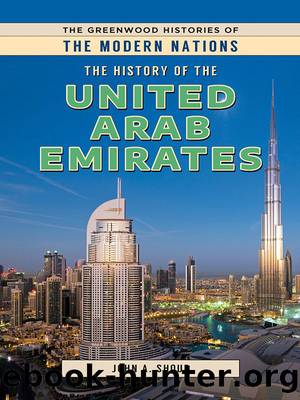The History of the United Arab Emirates by Shoup John A.;

Author:Shoup, John A.;
Language: eng
Format: epub
Publisher: ABC-CLIO, LLC
Published: 2022-11-15T00:00:00+00:00
PEARLING AND THE COLLAPSE OF THE INDUSTRY
Pearls served as the major source of economic power in the Arabian Gulf, and while dates were also exported, they could not compete with the price of pearls. Bahrain became the major center for the trade, and many Hawali families were involved in dealing with European buyers. Each year, European buyers came to Bahrain to see what types of pearls were offered for sale. For the pearl divers, it was an important time, when the ship captains and admirals of pearling fleets not only sold pearls to the buyers but also paid the sailors and divers. Bahrain had a number of good harbors that made it ideal for trade.11 It was also surrounded by smaller ports on the mainland of the peninsula, which included Uqair, Qatif, Zubara, and Bidaâ on the mainland of the Peninsula. Al-Qasimi notes that Bahrainâs trade in pearls had a steady growth from 1790 to the 1820s. It is estimated that twenty-five hundred ships were engaged in pearling, and the income from pearls rose to 2,459,200 Maria Theresa thalers (a silver coin similar to a U.S. silver dollar) or £490,000.12 Of this total amount, the shaykh of Bahrain taxed the sales of pearls at £10,000 (the amount for all the merchants annually as a group) for providing protection to the merchants. The harbors of Bahrain hosted baghlah and bum from Kuwait and Basrah to Bombay and Mombasa that brought in products from the Indian Ocean and the Arabian Gulf, including ârice, sugar, cloth, indigo, iron, brass, ghee, and timber from the Malabar Coast twice a year. From the Gulf ports Bahrain imported dates, sugar, ghee, cloth, gunpowder, swords, matchlocks and from the Hasa region and Qatif, goats, sheep, bullocks, cows, dates, donkeys, and horses.â13
Ras al-Khaimah (originally called Julfar) also had extensive trade in dates and pearls. Many of the Qawasim ships were large, able to hold cargos of some three to four hundred tons.14 The shaykh commanded a fleet of four hundred ships of different sizes, and the pearl fishing area had high-quality pearls that were located at a depth of six to seven fathoms close to the shore controlled by the Qawasim.15 The sale was around 40,000 Tumans (an Iranian currency) or the equivalent of 10,000 dinars, equaling one Tuman. The shaykh exacted a tax of one or two Maria Theresa thalers per ship, depending on the size, and 10 percent of sales on dates. The pearls from Ras al-Khaimah/Julfar were among the very best produced in the gulf, and foreign merchants tried to establish trading missions. However, the Qawasim traded mostly with other gulf ports and fewer, but still significant amounts with foreigners (non-Arabs). Sharjah also functioned as a pearling port, but until the defeat by the British of the Qawasim fleet, it was less important. After the defeat, the Qawasim capital moved to Sharjah, and its importance grew. Other ports in the lower gulf had fleets of pearling ships. In Dubai and Abu Dhabi, even though their
Download
This site does not store any files on its server. We only index and link to content provided by other sites. Please contact the content providers to delete copyright contents if any and email us, we'll remove relevant links or contents immediately.
| Africa | Americas |
| Arctic & Antarctica | Asia |
| Australia & Oceania | Europe |
| Middle East | Russia |
| United States | World |
| Ancient Civilizations | Military |
| Historical Study & Educational Resources |
Machine Learning at Scale with H2O by Gregory Keys | David Whiting(3632)
Never by Ken Follett(3528)
Fairy Tale by Stephen King(2950)
The Man Who Died Twice by Richard Osman(2808)
Oathbringer (The Stormlight Archive, Book 3) by Brandon Sanderson(2632)
Will by Will Smith(2580)
Rationality by Steven Pinker(2149)
The Dark Hours by Michael Connelly(2077)
The Dawn of Everything: A New History of Humanity by David Graeber & David Wengrow(2017)
Can't Hurt Me: Master Your Mind and Defy the Odds - Clean Edition by David Goggins(2004)
Friends, Lovers, and the Big Terrible Thing by Matthew Perry(1994)
Principles for Dealing With the Changing World Order: Why Nations Succeed and Fail by Ray Dalio(1894)
HBR's 10 Must Reads 2022 by Harvard Business Review(1697)
A Short History of War by Jeremy Black(1669)
Go Tell the Bees That I Am Gone by Diana Gabaldon(1599)
515945210 by Unknown(1520)
443319537 by Unknown(1395)
Kingdom of Ash by Maas Sarah J(1386)
A Game of Thrones (The Illustrated Edition) by George R. R. Martin(1368)
